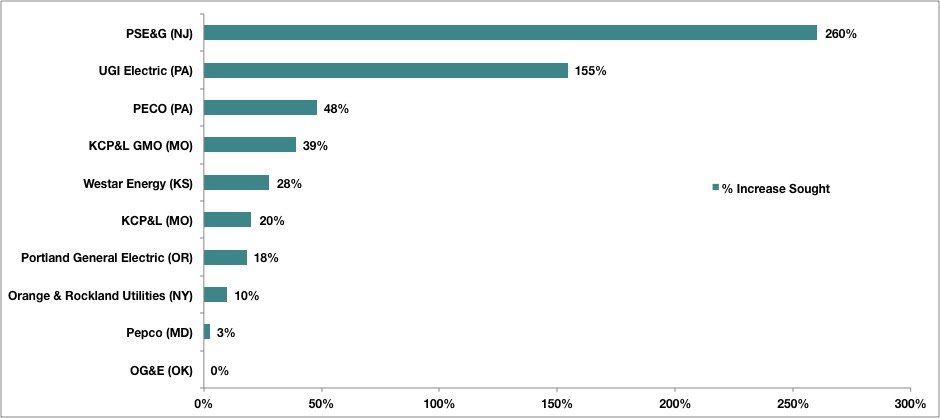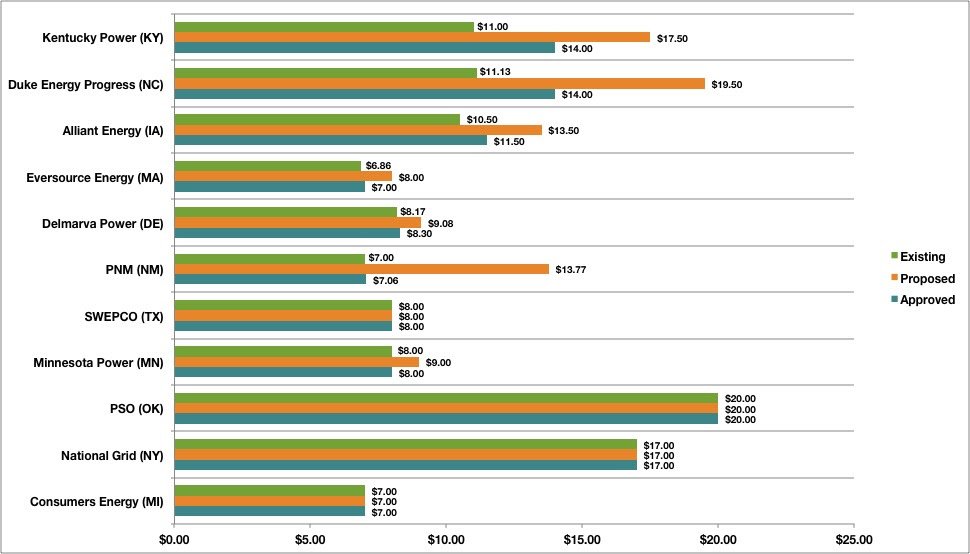Policy and politics are related, but they don't always align — particularly in this day and age. As Shane Skelton, a co-host of my new podcast, Political Climate, put it in our first episode: “Politics used to be a really creative away to advance your public policy objectives, and at this point the two are totally unrelated.”
That’s why GTM launched Political Climate — to have fun and informative conversations about how energy and environmental policy gets made, and the political interests behind it. Each episode I’ll be joined by Skelton, a former energy adviser to House Speaker Paul Ryan, and Brandon Hurlbut, former chief of staff to Energy Secretary Steven Chu, to discuss and debate how energy and environment issues fit into the broader political landscape. Listen to our first episode here.
This column, as you may know, takes the opposite approach. Here we get into the policy weeds and put the politics to the side. This week, we start with an update on general rate case filings, followed by a roundup of the latest state policy developments, including a solar bill stalled in South Carolina, an emissions trading proposal in Virginia, and EV legislation in Illinois.
Rate case update
The policy-watchers at EQ Research have read through the dockets and crunched the numbers to find 10 electric utilities in eight states filed general rate cases in the first quarter of 2018. In addition to the rate revisions, EQ found that GRCs are increasingly including proposals related to grid modernization, energy storage, electric vehicles and distributed solar.
Fixed charges emerged as the most common theme, however, with all but one utility proposing to increase their monthly fixed fee for residential customers. Five utilities sought to raise their residential fixed charge by 25 percent or more.
One utility, UGI Electric in Pennsylvania, which is undergoing its first general rate case in 22 years, asked to raise its residential fixed charge 155 percent — from $5.50 to $14.00. Another utility, PSEG in New Jersey, is looking to raise its charge 260 percent — from $2.27 to $8.18 — over three years. According to EQ Research, PSEG also proposed a new decoupling mechanism, dubbed a “Green Enabling Mechanism,” which would decouple revenues from sales. The utility argues this will encourage large-scale utility investments in efficiency, renewables and other clean technologies.
Proposed Residential Fixed-Charge Increases: GRCs Filed in Q1 2018

On the matter of fixed charge increases, regulators have frequently pushed back on utility requests. Eleven rate cases were decided in the first quarter and in eight of those cases state regulators did not allow residential fixed-charge increases to exceeding 2 percent. The average increase approved by regulators in these 11 cases was 6 percent, compared to an average proposed increase of 27 percent.
Clean energy advocates frequently object to fixed charge increases because these fees are unavoidable, which makes it less compelling for customers to try to reduce their energy consumption through efficiency measures, rooftop solar or energy storage.
Existing vs. Proposed vs. Approved Residential Fixed Charge Increases: GRCs Decided in Q1 2018

The latest policy news
South Carolina solar bill
A bill that would have raised net metering caps for solar projects in South Carolina has stalled on a technicality.
The legislation (HB 4421) passed with a majority vote in the South Carolina House last week, only to be defeated Tuesday on a procedural rule that requires two-third of members to approve the bill in order for it to advance. The House voted for the bill, 61-44, exceeding a simple majority but falling short of the new two-thirds requirement.
Solar advocates placed the blame on the state’s major utilities, SCANA and Duke Energy, for raising the procedural issue. According to the Solar Energy Industries Association, failure to pass the solar bill puts 3,000 solar jobs at risk.
Duke Energy took issue with abolishing net metering caps in the new law, and with language that prevented utilities from recovering costs from net-metered solar customers. “This is not about utilities protecting profits,” Duke spokesperson Ryan Mosier wrote in an email. “It’s about having a fair system, paying private solar customers the same, competitive price we pay for other solar energy, instead of above-market rates that result in higher costs for all customers.”
Proponents of the bill will now have to find a way to reintroduce the legislation before the state’s net metering caps are hit.
A renewables boost and nuclear subsidies in New Jersey
The New Jersey state legislature passed three pieces of clean energy legislation this week. One piece of legislation (A3723/S2314) boosts New Jersey’s renewable portfolio standard to 50 percent by 2030. It also boosts the state’s solar target to 5 percent by 2021, enables the launch of a community solar program and establishes a process to deploy 2 gigawatts of energy storage by 2030.
Another bill (S1217) directs the New Jersey Board of Public Utilities to accept applications for an offshore wind project near Atlantic City with up to 25 megawatts in nameplate capacity.
The third bill (S2313) approves a $300 million annual subsidy for the state’s remaining nuclear power plants, a move championed by Public Service Enterprise Group and Exelon. The bill specifically allows for cost recovery of up to $0.004 per kilowatt-hour within 180 days of enactment. Financial assistance is offered for up to four years, but does not specify a sunset date.
Competitive energy suppliers and some environmental groups are strongly opposed to the nuclear bill, calling it a “bailout” for the state’s struggling nuclear power plants. If S2313 passes muster with Governor Phil Murphy, New Jersey will become the latest state to implement a zero-emission certificate (ZEC) program for nuclear plant operators, following in the steps of New York and Illinois. Like the other states, New Jersey’s ZEC program is likely to face legal challenges.
Minnesota nuclear payments
Legislation working through both chambers of the Minnesota legislature would grant the state’s largest utility, Xcel Energy, approval for nuclear facility cost recovery before the money is spent. The utility commission currently uses rate cases to analyze returns after the utility pays. The bills echo wider debates about large nuclear power plants in the U.S. and who should pay for them. The Senate version passed out of committee earlier this month.
Illinois plan to reach 25% renewables
Also earlier this month, the Illinois Commerce Commission finalized the state’s Long-Term Renewable Resources Procurement Plan, which includes an outline for acquiring 25 percent of the state’s energy from renewable energy resources by 2025. Part of the plan is to procure 666 megawatts of community and distributed solar. It also encourages in-state renewables development, seeks to make solar more accessible to low-income communities, and tweaks the Illinois renewable energy certificate program so the state can spend on a forward-looking basis rather than buy RECs solely with spot procurements.
Carbon trading initiatives
The Virginia Department of Environmental Quality (DEQ) has proposed regulation to establish an emissions trading scheme in the Commonwealth — a move that was met with strong support from clean energy advocates.
“A regulation to reduce and cap carbon dioxide through a multi-state trading program like the Regional Greenhouse Gas Initiative (RGGI) makes sense for Virginia citizens and businesses,” said Lisa Jacobson, president of the Business Council for Sustainable Energy. “National data shows that the energy sector can reduce emissions while keeping costs low.”
The Virginia branch of Advanced Energy Economy calculated that the DEQ’s proposed carbon dioxide emissions trading program would drive up to $4.6 billion in in-state investment and add up to 40,000 new advanced energy jobs. It would also produce $80 million to $420 million in additional state and local tax revenue from renewable projects, depending on the compliance pathway.
The DEQ is in the process of reviewing public comments submitted last week and is expected to finalize the regulation in coming months. According to AEE, Virginia Governor Ralph Northam has signaled he would like to see the rule in place before the end of 2018. If approved, Virginia will become the first Southern state to put a cap on carbon emissions.
Meanwhile, lawmakers in New Jersey are looking to rejoin RGGI, six years after Governor Chris Christie withdrew. And in Maryland, legislators have proposed to make it harder for the state to leave the Northeast cap-and-trade program. Some lawmakers in New Jersey also want the state to join the U.S. Climate Alliance and uphold the Paris climate accord.
In contrast, legislators in New Hampshire proposed a measure that would withdraw the state from RGGI, although it was defeated in the House.
EV bills in Illinois
Two bills have been introduced in Illinois seeking to guide how the state distributes more than $108 million in Volkswagen settlement money.
The current plan put forward by the Illinois Environmental Protection Agency (IEPA) calls for allocating the majority of the funds toward replacing dirty fossil fuel locomotives, ferries and tugboats. Just 10 percent of the funds, or $10.8 million, is targeted specifically for EV projects — which are all related to replacing diesel school buses with electric ones. Under the current proposal, none of the funds will be put toward expanding access to EV charging.
The settlement language only allows up to 15 percent of funds to be used on EV projects. Still, the boost from 10 percent to 15 percent is something clean energy advocates in Illinois want to see.
One of the bills introduced (SB3055) would mandate that the full 15 percent be used for investment for light-duty EV infrastructure, while the remaining funds are used for the replacement of dirty diesel trucks and buses to all-electric.
The other bill (SB3101) requires that the IEPA create a VW Settlement Task Force from a diverse group of stakeholders. The 10-person group would be required to hold listening sessions, review public comments and, ultimately, produce a report on the VW funding agreement with recommendations to the governor and General Assembly by January 1, 2019.
Both bills are still in the early stage of working through the legislature. If passed, they could have a meaningful impact on the EV market in Illinois.
ICYMI: A few highlights from March
The governor of Utah signed a trio of solar power bills on consumer protection (SB 157), allowing utilities to rate-base large-scale solar (SB 261) and extending the state’s solar tax credit (SB 141).
The New Hampshire Senate approved legislation that would increase the state’s net metering system size limit from 1 megawatt to 5 megawatts, or up to 25 megawatts if no more than 5 megawatts of the output is net-metered. The bill would also launch a proceeding at the PUC to determine new solar compensation rates. The PUC would set an interim rate, which solar customers would be grandfathered into for 12 years. The PUC would then determine a final rate within three years, based on the results of a NEM tariff proceeding.
Virginia utility regulators approved Dominion Energy’s 2017 Integrated Resource Plan, which covers a 25-year study period extending to 2042 and anticipates annual increases of 1.3 percent in both future peak and energy requirements over this period. The plan lays out eight pathways to meet future energy needs, with or without the Clean Power Plan in place. All plans include:
- At least 5,200 megawatts of new solar generation within the 2018-2042 study period.
- 12 megawatts of generation from the Virginia Offshore Wind Technology Advancement Project as early as 2021.
- 990 megawatts of VA and NC solar generation from non-utility generators currently or expected to be under long-term contracts.
- 7.7 megawatts of Solar Partnership Program capacity where Dominion installs rooftop PV on customers’ premises.
Each of the plans that would comply with the CPP includes retiring a 790-megawatt oil-fired generation facility and 261 megawatts of coal-fired generation in 2022.